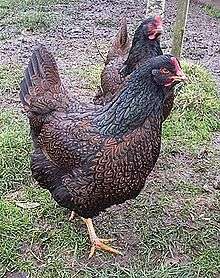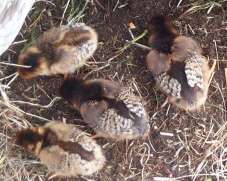Barnevelder
 Barnevelder double-laced hens | |
| Country of origin | The Netherlands |
|---|---|
| Traits | |
| Weight |
Male: Standard: 3.2–3.8 kg Bantam: 910 g |
|
Female: Standard: 2.3–2.7 kg Bantam: 740 g | |
| Classification | |
| APA | continental[1] |
| PCGB | soft feather: heavy[2] |
|
Chicken Gallus gallus domesticus | |
The Barnevelder is a medium heavy breed of chicken named after the Dutch town of Barneveld. It is a cross of 19th century Dutch landrace chickens with Asian breeds imported to Europe in the mid-late 19th century such as the Brahma, Cochin, Croad Langshan and Malay.
History
Hans Schippers, the Dutch authority on the breed, reports the following on the development of the Barnevelders:[3] Between c. 1850 and 1875 Cochin, Malay, Brahma and Croad Langshan arrived from Asia and were crossed with local fowl. One particular strain of brown egg laying fowl were like Black Cochins in appearance and were kept as a meat bird (these were not, however, purebred Cochins). Around 1885 these birds were crossed with Brahmas and the offspring of this cross was crossed with Langshan. In 1898 American utility birds ("Amerikaanse Nuthoenders"), a rough version of the Golden Wyandotte (apparently not dissimilar to the American Winnebago, a ‘precursor’ to the Golden-laced Wyandotte) were crossed into the developing breed followed in 1906 by Buff Orpingtons. Overall in the development to follow the Croad Langshan continued to have the biggest influence and contributed hardiness, brown eggs and good winter production.
A similar account, bar the influence of the "Amerikaanse Nuthoenders", was given in 1930 by P. L. Wijk, District State Poultry Expert, Apeldoorn and P. Ubbels, State Poultry Consultant, Beekbergen, The Netherlands in his contribution on The Origin of the Barnevelder and Welsummer Breeds.[4] According to Wijk & Ubbels, efforts were made to obtain more uniformity in colour and type from 1910 onwards and the name Barnevelder dates from that time. An Association of Barneveld Breeders was established in 1921 which fixed the standard.
Indian Game (Cornish) may have been crossed into the Barnevelders in Britain sometime after their importation into Britain in the 1920s.[5]
The breed gained worldwide recognition and was exported to many countries because of its ability to lay approximately 180-200 large brown eggs per year.
Characteristics


Today, Barnevelders are bred both as a utility breed and a show breed. They are medium heavy dual-purpose chickens laying a good number of eggs but also yielding a reasonable carcass. They are hardy birds and good foragers. While they became famous for their dark brown eggs in the first half of the 20th century most birds now appear to be in the hands of show breeders and not much attention has been given to maintaining the dark brown egg colour or to productivity with the focus being on external characteristics instead. Many flocks now lay eggs of a much lighter brown than before and are sometimes not quite as productive as befits their reputation. They are good winter layers and have a quiet disposition.
Varieties
The original and most well known Barnevelder is the double laced variety with a single vertical comb and yellow legs, but white, black, brown, partridge, blue and double laced blue varieties also exist. Not all countries recognize all these varieties in their Poultry Standards. There are large fowl as well as bantam versions of most of the different colours.
Double-laced (large fowl) Late 19th/early 20th century. Bred in Barneveld, Netherlands. History as above.
Double-laced (Bantam) Recognized in 1931 in Germany. Bred from a 'petite' double-laced hen and a Bantam Rhode Island Red cock, followed by crossings with Bantam Golden-laced Wyandottes, Bantam German Langshan, and Bantam Indian Game (Cornish).
Black (large fowl) 1920s. Black came as a sport from the partridge. Black Plymouth Rock and Black Wyandottes were crossed in to achieve pure black.
Black (Bantam) Recognized in 1954 in Germany. Bred from Black Barnevelders and Bantam Black Wyandottes in Germany.
White (large fowl) 1934. Occasionally occurring recessive white birds were crossed with white Plymouth Rocks and White Leghorn to produce White Barnevelders.
White (Bantam) Recognized in 1960 in Germany. Bred from Black Barnevelders and Bantam White Wyandottes in Germany.
Autosexing barred (large fowl) 1930-1939. Produced by Haagedorn.[6] Don't seem to have persisted.
Autosexing barred (Bantam) Recognized in Germany in 1988. Bred in Germany with the aid of autosexing Bantam Bielefelder. Bantam Niederrheiner and Bantam Italiener (German-type Leghorn) were also crossed in.[7]
Dark brown (large fowl) 1978? Recognized in 1982 in Germany. Bred from Black Barnevelders, Rhode Island Reds and New Hampshires in Germany.
Dark brown (Bantam) Recognized in 1987 in Germany. Bred from Bantam Black Barnevelders, Bantam Rhode Island Reds and Bantam New Hampshires in Germany.
Partridge (large fowl) Partridge Barnevelders were still kept in Britain in the 1990s, possibly still derived from early imports.
Chamois(Large fowl & Bantam) Double laced feather pattern of gold-mahogany and white, recognized in New Zealand Poultry Standards 2013.
Double-laced Blue (large fowl) Recognized in New Zealand Poultry Standards 2013.
Double-laced Blue (Bantam) Originally bred in the Netherlands. Bred again in Germany from a Bantam double-laced Barnevelder cock and a Bantam blue-laced Wyandotte hen; recognized in 1987.
Blue (large fowl) Recognized in Germany in 1997. Bred from Black Barnevelder and Blue Niederrheiner. Not recognized in the Netherlands.
Silver (large fowl) Appears to be a recognised variety in the British & Australian Poultry Standards. Single-laced.
Silver-black double-laced (Bantam) Developed in the first years of the new millennium by Dutch breeder Bert Beugelsdijk from crosses of double-laced Barnevelder bantams and Silver-pencilled Wyandotte bantams. Recognised in 2009.[8]
Silver-black double-laced (large fowl) Developed by the Dutch breeders Gerrit Simmelink and Cor Tensen from crosses of a large Silver-pencilled Wyandotte rooster and large double-laced Barnevelder hens. Recognised in 2013.[9] Also recognized in New Zealand Poultry Standards 2013.
The double-laced pattern

Genetically, the double-laced feather pattern phenotype has been shown to depend upon homozygosity of both the linked eumelanin extension melanotic (Ml/Ml) and the feather pattern arranging gene (Pg/Pg). In the Barnevelder (large fowl), the pattern is expressed on a brown (e^b/e^b) background.[10] Only the females express the double-laced pattern, whereas the males are melanized black-breasted reds.
References
- ↑ APA Recognized Breeds and Varieties as of January 1, 2012. American Poultry Association. Accessed August 2014.
- ↑ Breed Classification. Poultry Club of Great Britain. Accessed August 2014.
- ↑ Schippers, Hans L. (2004) Barnevelder Kippen. 144 pp. Netherlands. ISBN 90-901301-4-4 (Dutch language with English and German summaries)
- ↑ Wijk, P. L. & P. Ubbels (1930): "The origin of the Barnevelder and Welsummer Breeds; and some Egg Production Figures of the Principal Dutch Utility Breeds., No. 17, p. 99, in: Report of Proceedings of the 4th World’s Poultry Congress at the Crystal Palace, London, England, July 22–30, 1930. Published by His Majesty’s Stationery Office 1931.
- ↑ Batty, Joseph (1999) Barnevelder Fowl - History and Management of This Popular Breed Which Lays Deep Brown Eggs, 112 pp, Paperback, Beech Publishing House. ISBN 1-85736-353-1
- ↑ "Core Historical Literature of Agriculture". Chla.library.cornell.edu. Retrieved 2012-02-19.
- ↑ Archived September 27, 2007, at the Wayback Machine.
- ↑ http://www.aviculture-europe.nl/nummers/09E03A14.pdf
- ↑ http://www.levendehave.nl/nieuws/barnevelder-nu-ook-zilver-zwart-dubbel-gezoomd
- ↑ ""Carefoot WC"[Author] - PubMed - NCBI". Ncbi.nlm.nih.gov. 2012-01-09. Retrieved 2012-02-19.
- Barnevelder und Zwerg-Barnevelder Schriftenreihe für Geflügelkunde, 4. Aufl., 48 pp, Verlag Reutlingen Oertel & Spoerer 1989, ISBN 3-88627-078-5 (German language)
![]() Media related to Barnevelder at Wikimedia Commons
Media related to Barnevelder at Wikimedia Commons